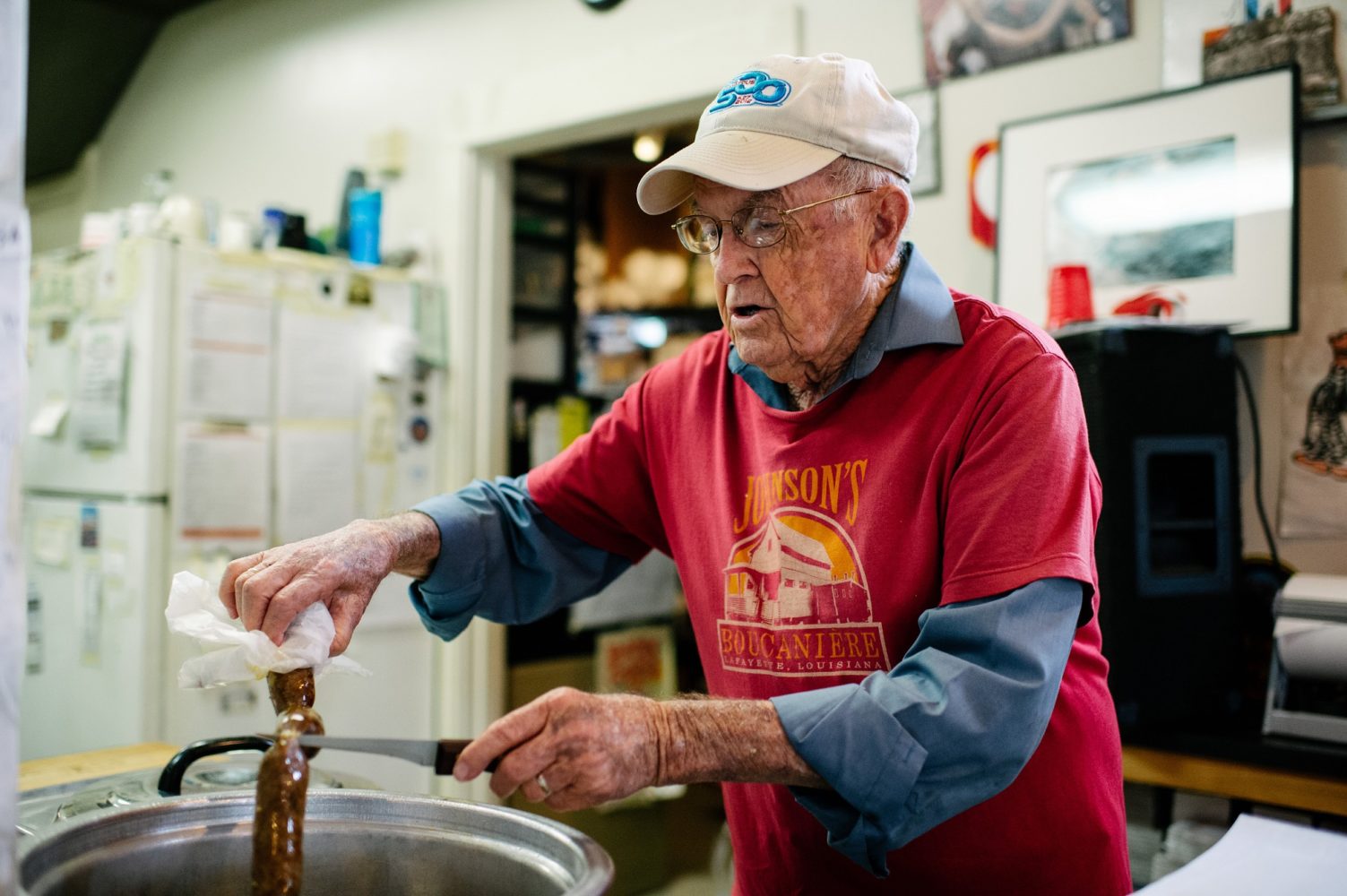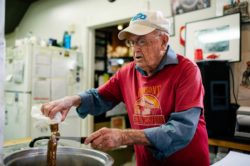Desperately Seeking Boudin
A hymn to the cherished sausage
Published: August 30, 2019
Last Updated: December 1, 2019

Photo by Paul Kieu
Wallace Johnson of Johnson's Boucanière in downtown Lafayette retrieves links of boudin for a customer. Johnson, the owner of the former Johnson's Grocery in Eunice, currently works the counter at the Lafayette restaurant owned by his daughter Lori Walls and her husband Greg Walls.
Although the archival record may never reveal the precise origin of Louisiana’s boudin sausage, we do know that, like the Cajun people, it traces its culinary lineage back to France. The French have a sausage called boudin blanc, which translates to “white pudding.” (A pudding, in this case, is a savory blend of meat, offal, and a grain filler.) French boudin blanc is a sausage made with emulsified pork, chicken, and/or veal mixed with milk, cognac, and spices. Other such sausages or puddings include Scottish haggis, made with sheep offal and oatmeal, and English black pudding, incorporating both pork blood and barley.
One of the earliest recorded recipes for boudin in the United States bears scant resemblance to our modern incarnation, but it deserves consideration nonetheless. In 1805, on their famous journey to investigate the Louisiana Territory, Captain Meriwether Lewis and Lieutenant William Clark contracted with a French fur trapper named Toussaint Charbonneau. Charbonneau proved to be one of the most vexing personalities on the journey, but he did provide the crew with their first taste of boudin, and the preparation was colorfully recorded in the daily journal. The sausage, crafted fireside, was made of buffalo intestine stuffed with meat and kidney suet; the links were then “baptized” in the Missouri River with “two dips and a flirt,” boiled, and fried in bear grease. So struck were the explorers by the delicious concoction that they deemed it “one of the greatest delicacies of the forest.”
When the French Acadians (today’s Cajuns) left Nova Scotia for Louisiana starting in the 1760s, they adapted their traditions and culture to their new surroundings. Many made their way to the bayous, prairies, and backwoods of Louisiana, where life required ingenuity, flexibility, and creativity. So when they set out to make use of a freshly butchered hog, and to make good use of every single part of that animal, it was not much of a stretch for them to add some rice (as filler and flavor) to the “leftover” pork, mix it with the cayenne and seasonings at hand, push it into the intestines and call it what their European lineage led them to understand it as: boudin. Rice had been grown in Louisiana as early as 1718, and German immigrants to the region in the 1720s had already diffused their sausage-making traditions far and wide.
Prior to the 1940s, the only way to get a link of boudin in Louisiana was when rural farming populations gathered for a boucherie (a communal hog butchering). Some cuts went toward stews or roasts, while others went into the boucanière, where a long smoke would help preserve the meat for later use as bacon, tasso, or jerky. Meanwhile, the boudin (boudin rouge being made with the pig’s fresh blood and boudin blanc without it) went into a steaming pot of simmering broth and was consumed as part of the festivities of the boucherie. It was practical, filling, soul–satisfying, and scrumptious.
For well over a hundred years, the only place to come by boudin was through these local family boucheries. Then, in the 1940s, Wallace Johnson and his uncle Arneastor Johnson began selling links across the counter at Johnson’s Grocery in Eunice, Louisiana. Within ten years others were following suit. In 1955 Eula and Tom Savoie began selling boudin from their store, Savoie’s Grocery, outside of Opelousas, and soon became the first wholesaler of boudin. In no time, what started in Eunice as a Saturday–morning tradition blossomed into the widespread boudin industry that reaches from the heart of Cajun Country to Alexandria, Baton Rouge, New Orleans, and even East Texas. Johnson’s Grocery closed in 2005, but the Johnson family runs a restaurant in Lafayette (Johnson’s Boucanière) where they serve the original boudin recipe.
Today we find ourselves in a cultural moment that could aptly be described as the second great awakening of the boudin industry. The culinary landscape is filled with meat markets, grocery stores, and restaurants making their own unique boudin recipes. The city of Scott, Louisiana, has named itself the Boudin Capital of the World. Annual boudin events take place from Lake Charles to Lafayette and down to New Orleans, and every week tens of thousands of pounds of boudin are eaten throughout the state. Still, in many ways, every time a person takes a bite from a tasty link of boudin, they are celebrating a tradition that goes back to the earliest days of Acadian settlement across Louisiana.
Robert Carriker, PhD, is a Professor of History at the University of Louisiana at Lafayette and creator of boudinlink.com. He lives in Lafayette with his wife and two daughters.
